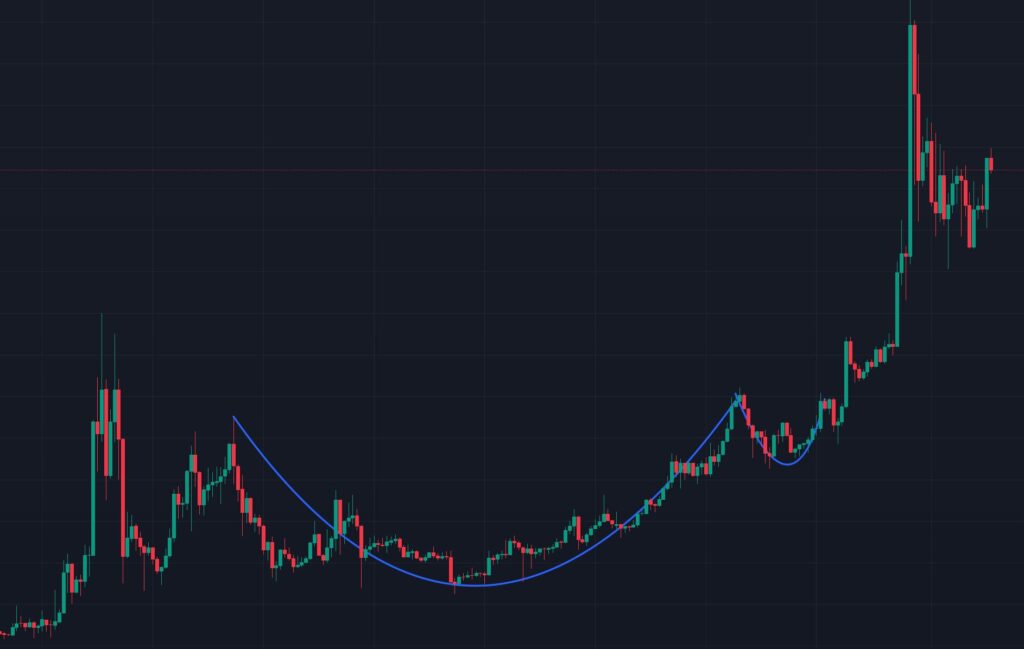The Cup and Handle is a widely recognized chart pattern used in technical analysis to identify potential bullish trading opportunities. This pattern usually signals a continuation of an uptrend, making it a favorite among traders looking to capitalize on price breakouts. The cup and handle pattern can also form at the bottom of a chart as a bullish reversal pattern. In this article, we’ll explore what the Cup and Handle pattern is, how it works, how to read it, and how traders can use it effectively.
What is the Cup and Handle Pattern?
The Cup and Handle is a bullish pattern that resembles the shape of a teacup with a handle. It typically forms after a strong upward price movement, indicating a period of consolidation before the price continues its upward trend. The pattern consists of two main components:
- The Cup: A U-shaped formation that represents a period of price decline followed by a recovery to near the previous high. The cup forms as the price drops, bottoms out, and then rises back to the level where the decline began.
- The Handle: A shorter, downward-sloping consolidation phase that follows the cup. The handle typically slopes downward or moves sideways, reflecting a brief pause before the price breaks out upward.
The pattern was popularized by William O’Neil in his book How to Make Money in Stocks and is commonly used in stock, forex, and cryptocurrency trading.

How Does the Cup and Handle Pattern Work?
The Cup and Handle pattern reflects market psychology during a period of consolidation and breakout. Here’s a breakdown of how it works:
- Cup Formation: After a strong uptrend, selling pressure causes the price to decline, forming the left side of the cup. As buying interest returns, the price gradually rises, creating the rounded bottom and right side of the cup. This phase shows that buyers are regaining control.
- Handle Formation: Once the price approaches its previous high, some traders take profits, leading to a short-term pullback or sideways movement (the handle). The handle is typically a brief consolidation period with lower trading volume, signaling reduced selling pressure.
- Breakout: When the price breaks above the resistance level (the peak of the cup), it confirms the pattern. This breakout is often accompanied by increased volume, indicating strong buying interest and the resumption of the uptrend.
The pattern is considered complete only when the price breaks out above the resistance level, signaling a potential opportunity to enter a long position.
How to Read the Cup and Handle Pattern?
To identify and read a Cup and Handle pattern, traders should look for the following characteristics:
- Prior Uptrend: The pattern typically forms after a clear upward price movement, indicating that the market is in a bullish phase.
- Cup Shape: The cup should resemble a “U” rather than a sharp “V.” The depth of the cup can vary, but it typically retraces 20-50% of the prior uptrend. The duration of the cup can range from a few weeks to several months.
- Handle Shape: The handle should slope downward or move sideways, with a duration of 1-4 weeks (shorter than the cup). The handle’s decline is usually shallower, retracing 10-20% of the cup’s height.
- Resistance Level: The peak of the cup forms a resistance level. A breakout above this level, ideally on high volume, confirms the pattern.
- Volume Patterns: Volume often decreases during the cup’s formation and handle’s consolidation. A spike in volume during the breakout signals strong bullish momentum.
How to Use the Cup and Handle for Trading?
Traders can use the Cup and Handle pattern to make informed trading decisions. Here’s a step-by-step guide to trading the pattern:
- Identify the Pattern:
- Use charting software or platforms to spot the U-shaped cup followed by a downward or sideways handle.
- Confirm the pattern by ensuring it meets the criteria (prior uptrend, proper cup and handle shapes, resistance level).
- Wait for the Breakout:
- Enter a long position only after the price breaks above the resistance level (the cup’s peak) with strong volume.
- Avoid entering prematurely during the handle’s formation, as the pattern may fail if the breakout doesn’t occur.
- Set Entry and Exit Points:
- Entry: Enter a buy order just above the resistance level or after the breakout is confirmed.
- Target Price: Estimate the target price by measuring the cup’s depth (from the peak to the lowest point) and adding it to the breakout point. For example, if the cup’s depth is $25, add $25 to the resistance level for the target.
- Stop-Loss: Place a stop-loss below the handle’s low to limit losses if the breakout fails.
- Monitor Volume:
- A breakout with high volume increases the likelihood of a successful trade. Weak volume may indicate a false breakout.
- Risk Management:
- Use proper position sizing to manage risk (e.g., risk no more than 1-2% of your account per trade).
- Be cautious of false breakouts, which can occur in volatile markets.
Tips for Trading the Cup and Handle
- Confirm with Other Indicators: Use additional technical indicators like moving averages, RSI, or MACD to confirm the breakout and avoid false signals.
- Consider Timeframes: The pattern can appear on various timeframes (e.g., daily, weekly). Longer timeframes often produce more reliable signals.
- Be Patient: Wait for the breakout confirmation to avoid entering too early during the handle’s formation.
- Watch Market Conditions: The pattern performs best in consistent markets. In choppy markets, false breakouts are more common.
Limitations of the Cup and Handle Pattern
While the Cup and Handle is a powerful tool, it’s not foolproof. Traders should be aware of the following limitations:
- False Breakouts: The price may break above resistance but fail to sustain the uptrend.
- Subjectivity: Identifying the pattern can be subjective, as the cup and handle shapes vary.
- Market Volatility: Choppy or low-volume markets can disrupt the pattern’s reliability.
- Time-Consuming: The pattern can take weeks or months to form, requiring patience.
Conclusion
The Cup and Handle pattern is a valuable tool for traders seeking to capitalize on bullish continuation trends. By understanding its structure, reading its signals, and applying disciplined trading strategies, traders can use this pattern to identify high-probability setups. However, success requires patience, confirmation of breakouts, and proper risk management. Combine the Cup and Handle with other technical indicators and market analysis to enhance its effectiveness, and always be prepared for the possibility of false signals.
Happy Trading!

